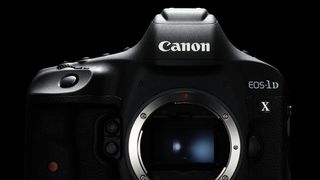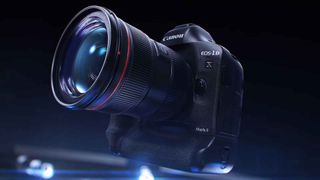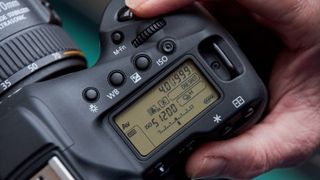Canon EOS 1D X Mark III: what we want to see in the flagship sports DSLR

Back in 2011, with a launch price of $6,799, the original Canon EOS 1D X was focused directly at the professional sports photographer. This full-frame DSLR housed an 18.1MP sensor, dual Digic 5+ processors, a 61-point autofocus (AF) system and a decent 14fps burst speed.
At that time, it was a pretty impressive snapper, although five years later the EOS 1D X Mark II outdid the older camera's performance, thanks to a pair of Digic 6+ engines working alongside a 20.2MP full-frame CMOS sensor.
Fast forward to 2019 and the rumors of a third-generation Canon sports DSLR have been heating up. And it makes sense for Canon to announce a brand-new sports DSLR with the 2020 Tokyo Olympics fast approaching.
The EOS 1D X Mark III, if it is going to see the light of day, will not be the only new pro-level camera for sports photographers next year. The third-gen Canon 1D X will likely give the Nikon D6 stiff competition if the rumored specs are to be believed.

Canon 1D X Mark III: release date and pricing
When the original EOS 1D X launched in 2011, it was an expensive camera, even for the professionals. Thankfully the EOS 1D X Mark II came with a slightly lower price tag of $5,999 / AU$7,999 and it's possible to get the camera body for less than that now.
That just goes to show that the EOS 1D X Mark III is not going to be cheap. We're expecting it to come in at about the same price as its immediate predecessor, if not more.
As for when you can expect it, there have been reports from way back in March that the Mark III was being field tested but no launch date was mentioned. Later it was predicted that the refreshed 1D X could arrive in 2020, although a more recent rumor indicates a more precise February 2020 announcement.
That does seem quite plausible as it matches the release date of the EOS 1D X Mark II, which was announced on February 1, 2016, just months before the Olympics in that year.
Moreover, reliable camera rumors site Nokishita has found that Canon has registered a new camera model codenamed DS126771 in Asia. It uses the same LP-E9 battery found in the Mark II snapper and so predictions are rife that it could be the next generation 1D X, also indicating we could hear something more official about it soon.
Canon EOS 1D X Mark III: design
The EOS 1D X line has a very chunky design, yet they are comfortable to use for most people.
The big brute that is the Mark II has a magnesium alloy build and weather sealing that it brought over from the original 1D X, but it did debut a double grip on the body – both vertical and horizontal.
The vertical grip on the Mark II has its own set of control buttons, making it easy to shoot in portrait orientation. The second generation model, despite its size, was easy to handle, thanks to some minor design tweaks, and we fully expect the same design ideas to be carried over to the Mark III.
Considering that Canon didn't make any significant changes to the body of the newly released EOS 90D (the only other DSLR to arrive in recent times), we think it will be very easy to switch over from the older camera to the new one when it arrives.
In fact, Canon Rumors is claiming to have "seen" product images and says that the Mark III looks very similar to the older camera. While we're unsure whether the images seen were for the pre-production model or the development prototypes, we're assuming it's the former. The only difference, says Canon Rumors in its report, is in the layout of the ports on the side of the camera and additional port covers.
Canon Rumors has previously reported that the rear LCD display will be similar to the one on the EOS R, meaning it could be a 3-15-inch tilt-angle touchscreen, but very little else is known about the design aspects of the 1D X Mark III.

Canon EOS 1D X Mark III: sensor and processor
The Mark II upped the pixel count from the first generation camera from 18.1MP to 20.2MP. You'd be forgiven for thinking that's a rather low sensor resolution for a camera of its caliber, but the 1D X line was built for speed and low-light shooting.
Having fewer pixels on a sensor means each photoreceptor is larger and, therefore, able to capture more light. That, in turn, results in less noisy results as the image signal requires less amplification as compared to a higher resolution sensor of the same size.
That said, we're expecting Canon to raise the resolution just a touch, and the latest report from Canon Rumors supports that prediction, with the rumors site claiming the 1D X Mark III will boast a 28.1MP full-frame CMOS sensor.
Keeping the tradition of dual processors alive, the Mark III is said to debut a brand-new imaging engine, with dual Digic 9 processors under the hood. If this rumor is true, it will be the first time a 1D X camera has debuted a new processor, and it will be the power of the two Digic 9 engines that will push the speed and performance of the Mark III above and beyond what the previous model can currently achieve.
Canon EOS 1D X Mark III: in-body image stabilization (IBIS)
An anonymous source has told Canon Rumors that the EOS 1D X Mark III will feature IBIS, which could be true as Canon has patented IBIS modules for both DSLRs and full-frame mirrorless cameras.
So far, IBIS has been a feature of mirrorless cameras, although Canon has traditionally shied away from it for all its snappers, DSLR and mirrorless alike. If the addition of IBIS is true, then shooting handheld, particularly in low light, will be a breeze and will likely please many users.
Canon EOS 1D X Mark III: continuous shooting / burst speed
Where the original 1D X and the Mark II version topped out at 14fps when shooting continuously, the Mark III model will reportedly shoot at a maximum of 30 frames each second. If that's true, the Canon DSLR will beat even Sony's new Alpha A9 II which has a burst speed of 20fps.
While it does seem like a ridiculously high number, this burst of speed could be possible if Canon does debut a new imaging engine in the Mark III. However, to save images being shot continuously as these speeds will require a camera with a high buffer depth. Currently, the 1D X Mark II is able to record an unlimited number of JPEGs and up to 170 RAW files.

Canon EOS 1D X Mark III: autofocus
We've got no idea if Canon will improve on the 61-point AF system currently in use in the Mark II model for the newer snapper, but Canon Rumors is reporting that it will remain the same albeit with the points spread over a "slightly" larger area.
While we're hoping that Canon increases the number of selectable AF points for the Mark III, enough that it covers most of the frame, we had absolutely no complaints when it came to the previous model. The EOS 1D X Mark II performs brilliantly when tracking moving subjects, even in low light.
Canon EOS 1D X Mark III: video specs
With dual Digic 9 processors under the hood, the EOS 1D X Mark III should easily be able to handle 4K video at 60fps. In fact, the Mark II does just that with an older processor under the hood, and captures 1080p footage at up to 120fps.
However, Canon Rumors has heard reports of the prototype Mark III capturing uncropped 6K video, and that could make its way to the final product. If true, that would put it ahead of the recently announced Canon EOS C500 Mark II cine camera, which offers 5.9K video output, and we're not entirely convinced that would happen as Canon wouldn't want its flagship sports camera competing with its cinema-centric full-frame shooter.
Canon EOS 1D X Mark III: card slots and connectivity
The EOS 1D X II has one CFast memory card slot and one regular CompactFlash slot. We're definitely not expecting to see the CompactFlash card slot brought over to the Mark III as it's a pretty old format now. However, Canon Rumors' latest report says that the memory card door is a "different shape", although what lies behind the door is still a mystery.
That said, we're expecting Canon to offer dual CFExpress card slots in the new camera, which will definitely be needed if the rumors of the forthcoming camera's speed are true.
And with both Wi-Fi and Bluetooth now available on most modern cameras, it would be a surprise if Canon omits either. If the camera registered in Asia under the code DS126771 is, indeed, the 1D X Mark III, then, according to Nokishita, it is coming with both Wi-Fi (IEEE 802.11b/g/n) and Bluetooth 4.1.

Comments
Post a Comment